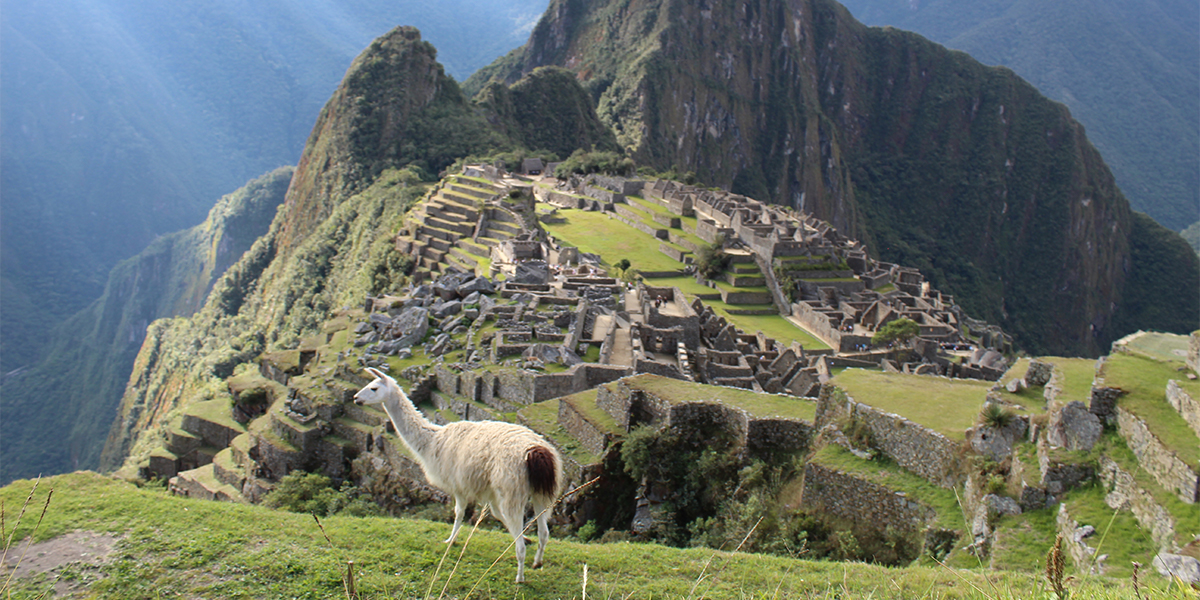I would hazard a guess that if you look at many people’s bucket list you would find a visit to Machu Picchu on there somewhere. Certainly everyone has an instant mental image of the breathtaking, mountaintop Inca citadel with its distinctive mountain formations (and the occasional photobombing llama!).
But what on earth is Machu Picchu, exactly?
Shrouded by mist and enveloped by lush vegetation, Peru’s most famous destination is set high in the Andes Mountains above the Urubamba River. Built in the 15th century, Machu Picchu was later abandoned a hundred years later at the time of the Spanish conquest of the Inca Empire. Machu Picchu’s sophisticated dry-stone ruins have made it the most famous archaeological site on the continent, a must for all visitors to Peru. In 2007, it was actually named one of the New Seven Wonders of the World.
Perched dramatically 1000 ft above the Urubamba valley, this awe-inspiring ancient city was remarkably well hidden and protected as it was never revealed to the conquering Spaniards. The Incans actually went out of their way to hide it from them as you will see if you and was virtually forgotten until the early part of the 20th century. These remarkable ruins were only rediscovered by the outside world in 1911 by locally led archaeologist Hiram Bingham.
But what was Peru’s most famous destination actually for?
Approximately 200 structures covering 80,000 acres make up the site… but was its main purpose ceremonial? Religious? Astronomical divination? Agriculture?
Machu Picchu is believed to have been built by Pachacuti Inca Yupanqui, the ninth ruler of the Inca, in the mid-1400s. While often characterized as an Inca citadel or fortress, the true purpose of Machu Picchu’s former use remains a mystery, with archaeologists only offering theories as to why it was built. One of the most popular and supported theories is the opulent Machu Picchu was built a retreat for Inca royals, and the presence of elite residences in the northeast sector of the site back this idea up.
Other theories include it being the last refuge of the Inca empire, a nunnery for the Virgins of the Sun, a sacred haven meant to honor the surrounding environment, a religious or administrative center, and even a re-creation of the mythic landscape of creation from the Inca religion. Whatever it’s purpose, archaeologists estimate that approximately 700-1200 people could have lived in the area. Due to its isolation from the rest of Peru, however, living in the area full time would require traveling great distances just to reach the nearest village.
Italian archaeoastronomer Giulio Magli recently proposed that an expedition along the Inca Trail from Cusco to Machu Picchu was more of a ceremonial pilgrimage meant to echo their origin myth. The same journey you can complete if you hike the Classic Inca Trail.
The preservation of ancient architecture and the breathtaking mountain vista it occupies has made Machu Picchu one of the most famous archaeological sites in the world today and the most important tourist attraction in Peru. No matter its purpose, hikers, tourists, and the early explorers describe similar emotions of awe as they trek the end of the Inca Trail. Gazing out on all the temples, fields, and terraces blending in with the hillside, the elegant green paradise seems to take you to another time. Machu Picchu is the icon of Inca civilization and like the Mona Lisa or the Giza pyramids, it has been seared into our collective consciousness and entices visitors from around the world.
Quick Facts of Machu Picchu
- On the Inca Trail, many porters sleep with a shiny metal object or mirror beneath them. They believe it sends away spirits coming up through the earth and whisks them away.
- Machu Picchu is made up of more than 150 buildings ranging from baths and houses to temples and sanctuaries.
- The compound contains more than 100 separate flights of stairs. Most of the individual staircases were carved from one slab of stone.
- Although many of the stones that were used to build the city were more than 50 tons, it is believed that no wheels were used to transport these rocks up the mountain. Rather, it is thought that hundreds of men pushed the heavy rocks up the steep mountainside.
- In the Quechua Indian language, “Machu Picchu” means “Old Peak” or “Old Mountain.”
- Machu Picchu was an astronomical observatory, and its sacred Intihuatana stone accurately indicates the two equinoxes. Twice a year, the sun sits directly over the stone creating no shadow.
If you wish to know more about the history of Machu Picchu make sure to include a stop at the Manuel Chávez Ballón Museum near Aguas Calientes while on your Machu Picchu visit.
